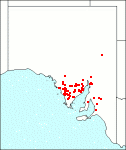Family: Orchidaceae
Pterostylis excelsa
Citation:
M. Clements, sp. nov.1
Synonymy: P. hamata sensu J. Weber & Bates in J. Black, Fl. S. Aust. 442 (1978), non Blackmore & Clemesha; P. milchellii Lindley forma major Lindley, Linnaea 26:236 (1853), nom. nud.; P. mitchelli sensu J. Black, Fl. S. Aust. 248 (1943), non Lindley.
, Oligochaetochilus excelsus, Pterostylis mitchellii Common name: Dry land green-hood.
Description:
Slender to robust. 8-80 cm high: leaves 5-20 in a radical rosette which is generally withered at flowering time, lanceolate to ovate-lanceolate, 2-8 cm x 8-18 mm: stem bracts 3-8, acute, scarious, closely sheathing, with one at the base of each pedicel, the lower ones partly imbricate, the distance between them increasing in the upper part of the stem.
Flowers 2-20, greenish with rufous markings, sometimes wholly green or maroon and white, on long pedicels; galea from the base to the crest 16-20 mm long, the apex produced into a fine point 3-12 mm long, opening of galea narrow; lateral sepals (lower lip) reflexed, straight near the base, about as long as the galea, their base conjoined, narrow, often ciliate, the lobes with a narrow sinus, produced into a fine point 1-3 cm long; labellum very irritable, on a wide movable claw, lamina ovate-lanceolate, 5-6 mm long, thick and fleshy often shaped like a shoe, conspicuously glandular, tip straight, sometimes slightly 2-fid, contracted toward the base, lamina hollowed out to within a short distance of the tip, a low rounded eminence at the base, with a crest of setae; lateral margins sparsely ciliate with long white hairs; under surface deeply and narrowly channelled; column incurved, reaching to the top of the galea; wings almost quadrangular, upper angles not toothed or ciliate, lower lobes blunt and ciliate, anterior margin witch a fringe of inturned hairs; stigma oblong-elliptical.
Published illustration:
Pocock (1972) Ground orchids of Australia, pl. 111 as P. boormanii.) Orchids of south-west Australia, p. 304 as P. aff. rufa.
|
|
Distribution:
|
Occurs singly or in populations which may be very extensive in semi-arid scrublands, mallee or about rock-outcrops, particularly inland, in areas receiving 200-500 mm mean annual rainfall. Widespread and locally common.
S.Aust.: GT, FR, EP, NL, MU, YP, SL, SE. Vic.
|
Conservation status:
native
Flowering time: Aug. — Dec.
|

SA Distribution Map based
on current data relating to
specimens held in the
State Herbarium of South Australia
|
Biology:
Some of the State's herbarium specimens resemble P. mitchellii which is a smaller more slender species endemic to south-east Qld (inland) while some larger specimens resemble P. hamata particularly when pressed. P. hamata, which is confined to the eastern States, is however quite distinct. Putative hybrids have been reported with P. biseta (EP, MU, YP) and P. boormanii (FR, EP).
Taxonomic notes:
Pterostyis excelsa M. Clements, sp. nov. Affinis Pterostylidi mitchellii Lindley, a qua habitu omnino robusto, ad 85 cm alto; floribus atro-brunneis, -rubris vel -viridibus: sepalis lateralibus in dimidio proximali non late patentibus, apicibus filamentosis 1-3-cm longis: et labello lanceolato carnoso atro, cum setis deorsum curvatis in marginibus lateralibus et crista setarum brevium in labo basili, differt. Holotype: Cultivated Australian National Botanic Garden ex "South Australia, Eyre Peninsula, Koongawa, Waddikcc Rocks". 28 Nov. 1978, M. A. Clements 1600E (CBG), Isotype: AD.
Author:
Not yet available
|

